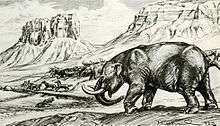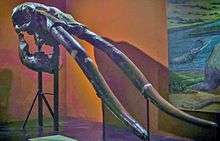Stegomastodon
| Stegomastodon Temporal range: Late Pliocene to Holocene | |
|---|---|
| | |
| S. mirificus fossil at the Smithsonian natural history museum | |
| Fossil | |
| Scientific classification | |
| Kingdom: | Animalia |
| Phylum: | Chordata |
| Class: | Mammalia |
| Order: | Proboscidea |
| Family: | †Gomphotheriidae |
| Genus: | †Stegomastodon Pohlig, 1912 |
| Species | |
| |
Stegomastodon ('roof breast tooth') is an extinct genus of gomphothere, a family of proboscideans. It is not to be confused with the genus Mammut from a different proboscidean family, whose members are commonly called "mastodons", nor with the genus Stegodon, from yet another proboscidean subfamily, whose members are commonly called "stegodonts".
Description


Stegomastodon mirificus is known from NMNH 10707, a 30-year-old male known from most of a skeleton. It was 2.6 metres (8.5 ft) tall, with a weight around 4.7 tonnes (4.6 long tons; 5.2 short tons).[1] Like modern elephants, but unlike most of its closer relatives, it had just two tusks. These tusks curved upward and were about 3.5 metres (11.5 ft) long. Stegomastodon's molars were covered in enamel and had a complex pattern of ridges and knobbly protrusions on them, giving the creature a large chewing surface that enabled it to eat grass. Its brain weighed about 11 pounds (5 kg).
It lived in North and South America. The two South American species arrived following the Great American Interchange. They were initially mixed feeders; S. waringi evolved toward grazing, while S. platensis evolved toward browsing.[2] The Stegomastodon species occupied warmer, lower-altitude habitats east of the Andes, while the related gomphothere Cuvieronius hyodon occupied cooler, higher-altitude habitats.[2] It has been carbon dated to 27,910 BP in the Chapala Lake region,[3] Jalisco, Mexico, as of now its most recent presence in North America, with its latest occurrence as recently as 6,060 BP in Yumbo, Valle del Cauca, Colombia.[4] [5]
References
- ↑ Larramendi, A. (2016). "Shoulder height, body mass and shape of proboscideans" (PDF). Acta Palaeontologica Polonica. 61. doi:10.4202/app.00136.2014.
- 1 2 Prado, J. L.; Alberdi, M. T.; Azanza, B.; Sánchez, B.; Frassinetti, D. (2005). "The Pleistocene Gomphotheriidae (Proboscidea) from South America". Quaternary International. 126-128: 21–30. Bibcode:2005QuInt.126...21P. doi:10.1016/j.quaint.2004.04.012.
- ↑ Alberdi, María Teresa; Juárez-Woo, Javier; Polaco, Oscar J.; Arroyo-Cabrales, Joaquín (2009-02-01). "Description of the most complete skeleton of Stegomastodon (Mammalia, Gomphotheriidae) recorded for the Mexican Late Pleistocene". Neues Jahrbuch für Geologie und Paläontologie - Abhandlungen. 251 (2): 239–255. doi:10.1127/0077-7749/2009/0251-0239.
- ↑ Rodríguez-Flórez, Carlos David; Ernesto León Rodríguez-Flórez y Carlos Armando Rodríguez (2009). "Revision of Pleistocenic Gomphotheriidae Fuana in Columbia and case report in the Department of Valle Del Cauca" (PDF). Scientific Bulletin. Museum Center - Natural History Museum. 13 (2): 78–85. Retrieved 2010-11-09. Cite uses deprecated parameter
|coauthors=(help) - ↑ Correal Urrego, Gonzalo; van der Hammen, Thomas (2003). "Supervivencia de Mastodontes, Megaterios y presencia del hombre en el valle del Magdalena (COLOMBIA) entre 6000 y 5000 AP." (PDF). Revista de la Academia Colombiana de Ciencias Exactas, Físicas y Naturales. Academia Colombiana. 27 (103): 159–164. Retrieved 2010-11-09.